
The Heptanese School of painting succeeded the Cretan School as the leading school of Greek post-Byzantine painting after Crete fell to the Ottomans in 1669. Like the Cretan school, it combined Byzantine traditions with an increasing Western European artistic influence and also saw the first significant depiction of secular subjects. The school was based in the Ionian Islands, which were not part of Ottoman Greece, from the middle of the 17th century until the middle of the 19th century. The center of Greek art migrated urgently to the Ionian islands but countless Greek artists were influenced by the school including the ones living throughout the Greek communities in the Ottoman Empire and elsewhere in the world.

San Giorgio dei Greci is a church in the sestiere (neighborhood) of Castello, Venice, northern Italy. It was the center of the Scuola dei Greci, the Confraternity of the Greeks in Venice. Around this period there was a similar church in Naples called Santi Pietro e Paolo dei Greci. There was also a Greek Brotherhood of Naples.

Emmanuel Tzanes, also known as BounialisEmmanuel Tzane-Bounialis, Emmanuel Zane, and Emmanuel Tzane. He was a Greek Renaissance painter. He was an author, clergyman, painter, and educator. He was the parish priest of the church of San Giorgio dei Greci. An important Greek church in Venice. He was affiliated with the Flanginian School of the Greek Confraternity in Venice. He was a prominent painter. His known works number over 130 pieces. His works can be found in public foundations, private collections, churches and monasteries in Greece. He collaborated with many artists namely Philotheos Skoufos. Both artists were members of the Cretan School. He was influenced by the Venetian school. Emmanuel's brothers were famous painter Konstantinos Tzanes and poet Marinos Tzanes. His most popular work is The Holy Towel finished in 1659.

Nikolaos Doxaras. He was a Greek painter and teacher. His father was famous painter Panagiotis Doxaras. Panagiotis Doxaras was the father of the Greek Rococo and the Modern Greek Enlightenment in art. They are both prominent members of the Heptanese School. They refined Greek art bringing the Maniera Greca into the Maniera Italiana. Artists he influenced include: Nikolaos Kantounis, Nikolaos Koutouzis and Gerasimos Pitsamanos. His influence can be seen in some of Nikolaos Kantounis's paintings notably The Assumption. Nikolaos taught famous painter Nikolaos Koutouzis. Both Nikolaos Koutouzis and Doxaras artistic style refined the art of the Ionian Islands. Venetian painting influenced countless Greek artists who were living in the empire. From Michael Damaskinos to Theodore Poulakis. Twenty years after Nikolaos's death the style came to an end due to the Fall of the Republic of Venice. A new artistic style developed after the Greek Rococo which coincided with Neoclassicism in the rest of Europe called the middle Modern Greek Enlightenment in art also known as Neo-Hellenikos Diafotismos.
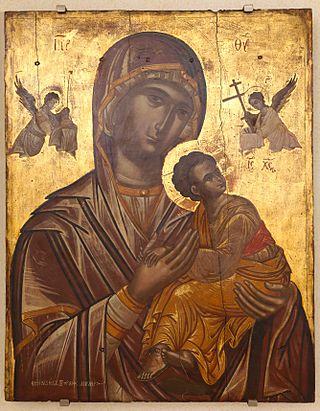
Emmanuel Tzanfournaris, also known as Emmanouil Manos was a Greek painter. He was a painter in Corfu and Venice. He was taught by famous painter Thomas Bathas. Emmanuel's father Georgios was also a famous painter. Emmanuel was active within the Greek Community of Venice until 1625. Some of his paintings are in the church of San Giorgio dei Greci. He was influenced by Michael Damaskinos and other Venetian painters. Tzanfournaris adopted the Venetian school but also stayed loyal to the maniera greca. He influenced the works of countless painters namely Emmanuel Tzanes, Franghias Kavertzas, Philotheos Skoufos and his son Theofilakto Tzanfournaris. Tzanfournaris artwork can be found all over the world. Sixteen of his paintings have survived.

Konstantinos Tzanes was a Greek Renaissance painter. He was a painter in Crete and Venice. His brother Emmanuel Tzanes was the parish priest of the church of San Giorgio dei Greci. Emmanuel Tzanes was also a famous painter and author. Konstantinos followed the Venetian style and in some instances completely broke from the maniera greca. His other brother Marinos Tzanes was a famous poet. Konstantinos's work influenced both Greek and Italian Painters. His most popular work is the painting by Mary Magdalene which is at the Greek Institute in Venice.
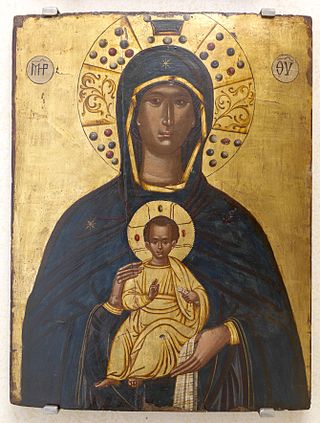
Thomas Bathas was a Greek painter, educator, and Vikar. He employed the maniera greca in some of his work but he also broke from tradition by employing the Venetian style. He traveled around the Venetian Empire going from Heraklion to Corfu and Venice. He was a prominent member of the Greek Confraternity in Venice. He was friends with Gabriel Severus, Metropolitan of Philadelphia. He was very popular among both Greek and Italian patrons. He influenced the works of countless artists both Italian and Greek. Some of his works are in San Giorgio dei Greci and the Hellenic Institute of Venice. Emmanuel Tzanes, Konstantinos Tzanes, Ioannis Moskos, and Philotheos Skoufos were some Greek artists influenced by his work. One of his students was the famous painter Emmanuel Tzanfournaris. He left him a fortune in his will. His most famous works include: Portrait of Gabriel Severus and Virgin and Child Enthroned. Twenty of his paintings have survived.

Antonios Papadopoulos was a Greek painter who represented the Cretan Renaissance. Papadopoulos, Andreas Pavias, Andreas Ritzos, and Nikolaos Tzafouris were all students of famous painter Angelos Akotantos. Papadopoulos reflects the sophistication and evolution of Byzantine painting to a more refined Venetian style. Although Cretan painting continued the tradition of the maniera greca, every icon reflected its own sophistication and uniqueness. Papadopoulos and his contemporaries influenced countless artists, namely Emmanuel Lambardos, Emmanuel Tzanfournaris, Thomas Bathas, and Markos Bathas. His most notable artwork is the Nursing Madonna or Galaktotrophousa. El Greco painted similar subject matter.

The Virgin Nikopoios also known as Panagia Nikopoios is a tempera painting by Thomas Bathas. Bathas was active in Heraklion, Venice, and Corfu during the second half of the 16th century. The painting follows the traditional Byzantine style characteristic of the traditional maniera greca. The painting also featured the Venetian style. The position of the Virgin and Child is the Nikopoios. The word Nicopeia is indicative of Constantinople. There are actually many different types.
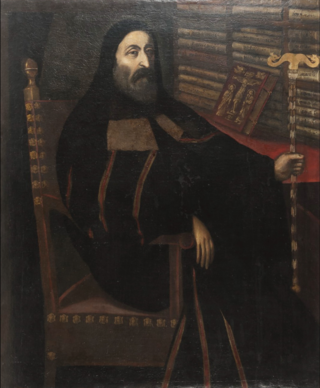
Portrait of Gabriel Severus is an oil painting by Thomas Bathas. Bathas was active in Heraklion, Venice, and Corfu during the second half of the 16th century. He was close friends with Gabriel Severus, the Metropolitan of Philadelphia, whose seat was moved from Philadelphia to Venice in 1577. According to the will of Bathas, he bequeathed Gabriel Severus a silver cup. He also made Severus the executor of his will.

The Stoning of Saint Stephen is an egg tempera and gold leaf painting created by Greek master Michael Damaskinos. He was a member of the Cretan school. He integrated Venetian painting with the Greek mannerisms prevalent at the time. Damaskinos was active in Heraklion, Sicily, Venice, and other parts of Italy. The Stoning of Stephen has been depicted by countless Greek and Italian painters. Saint Stephen was a protomartyr. He was the first martyr of Christianity. He was stoned to death for following the new faith. The painting is a depiction of that event.
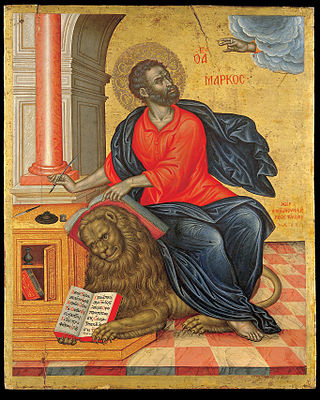
Saint Mark is a tempera-on-wood painting created c. 1657 by Emmanuel Tzanes. Tzanes was a Cretan painter who migrated to Corfu and Venice. He settled in Venice with his brothers Konstantinos Tzanes and poet Marinos Tzanes. Konstantinos was a famous painter. Their combined existing works number over 150. Emmanuel replaced Greek painter Philotheos Skoufos as the priest of San Giorgio De Greco.

The Crucifixion is a painting created by Georgio Markazini. Markazini was a Greek painter from the island of Crete. He migrated to Venice. He was active during the middle part of the 17th century. Two of the painter's works survived. The crucifixion was a very popular subject among Cretan painters. Andreas Pavias, Emmanuel Lambardos, and Theophanes the Cretan created a similar style crucifixion. The Cretan painters frequently influenced each other.

Lady the Lambovitissa is a tempera painting by Emmanuel Tzanes. Tzanes was a Greek painter active from 1625 to 1690. His artistic periods can be broken into three parts. The Cretan Period (1625-1647), The Corfu Period (1647-1655), and the Venetian Period (1655-1690). He was a prominent member of the Late Cretan School. His art was heavily influenced by Greek painter Michael Damaskinos. His brothers Marinos Tzanes and Konstantinos Tzanes were both painters. Tzanes has a massive art collection attributed to him nearing over one hundred thirty works. During the Corfu Period (1647-1655), Konstantinos Tzanes and Emmanuel were heavily active. They painted many works on the island.

The Virgin Glykofilousa with the Akathist Hymn is a tempera painting created by Greek painter Stephano Tzangarola. The work is a symbol of the craftsmanship of the Heptanese School and the evolution of Greek painting from the Byzantine style to the Cretan Renaissance style. Tzangarola was originally from Crete and migrated to Corfu. The Ionian Islands became the artistic center of the Greek world. He was active from 1675 to 1710 during the Greek Baroque period and Rococo. Twenty-two of his works survived. His student was famous Greek painter and Archpriest Andreas Karantinos.

The Holy Family is an oil painting created by Greek painter Panagiotis Doxaras. He was a prominent member of the Heptanese School. He was also an author. His son Nikolaos Doxaras was also a famous painter. Panayiotis was from a small village named Koutifari, close to Kalamata. He moved to Zakynthos at a young age. He studied painting with famous painter Leos Moskos. He traveled all over the Venetian empire with the famous artist including Venice. He studied painting in Venice for five years. He became a theoretical painter. He wrote several books on painting. He traveled all over the Ionian Islands. He lived in Lefkada, Zakynthos, and Corfu. He frescoed the ceiling of Panagia Faniromeni in Zakynthos. Eighteen of his paintings survived.

Saint Spyridon, John the Baptist, Saint Peter and Saint George is an oil painting created by Greek painter Nikolaos Koutouzis. He was a prominent member of the Heptanese School of painting. He was from the island of Zakynthos. He studied with Nikolaos Doxaras and Giovanni Tiepolo. He was an active painter for over fifty years. One hundred and thirty-six paintings are attributed to the artist. He was active from 1750 to 1813.
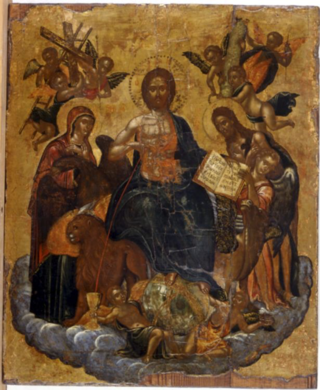
Tribute to the Eucharist was a painting made of egg tempera and gold leaf on a wood panel. The portable icon is attributed to Greek painter Michael Damaskinos. Damaskino's existing catalog features over 100 known works. He was a member of the Cretan school of painting. He was from the island of Crete. His contemporaries were Georgios Klontzas and El Greco. Damaskinos traveled all over Italy for over twenty years. He spent a significant amount of time in Venice. He adopted Italian mannerisms. He applied these new attributes to his paintings. He was friends with sculptor Alessandro Vittoria. He had a collection of drawings obtained from other Italian artists. Namely the Mannerist Parmigianino. He was also exposed to the magnificent works of Italian painter Raphael.

The Holy Trinity is a tempera painting created by Spyridon Romas. He was a Greek painter from Corfu. He was a prominent member of the Heptanese School. He was active from 1745 to 1786. He traveled all over the world. He painted in Corfu, Lecce, Livorno, and London. According to the Hellenic Institute over 25 of his works survived. He is one of the few Greek painters to completely adopt a new style of painting. He traveled to London, England around 1770 and remained in the country until his death. He painted several portraits but also maintained artwork in the region. An iconostasis with most of his works is superlatively preserved in Livorno, Italy at the Museo della Città di Livorno.

The Virgin and Child Enthroned is a tempera painting created by Spyridon Romas. He was a Greek painter from the island of Corfu and a prominent member of the Heptanese School active from 1745 to 1786 in Corfu, Lecce, Livorno, and London. Twenty-five of his works survived according to research completed by the Hellenic Institute. One of few Greek painters that changed his style completely Romas transitioned from the Heptanese School to the British style of painting. He traveled to London, England around 1770, and remained in the country until his death. Romas painted several portraits but also maintained art. An important iconostasis containing most of his works is preserved in Livorno, Italy at the Museo della Città di Livorno.



















